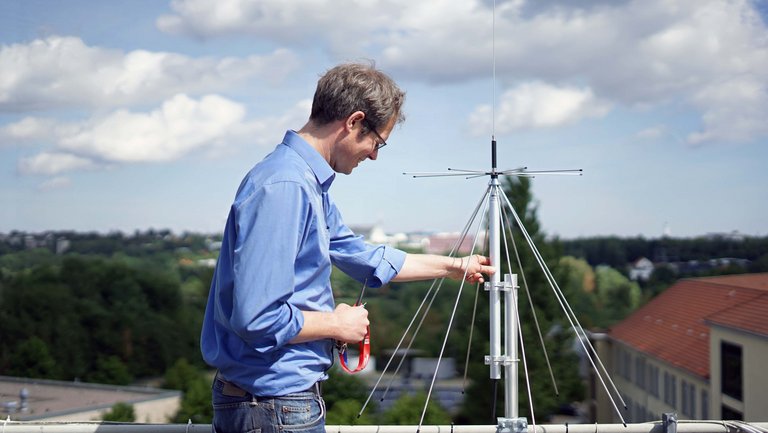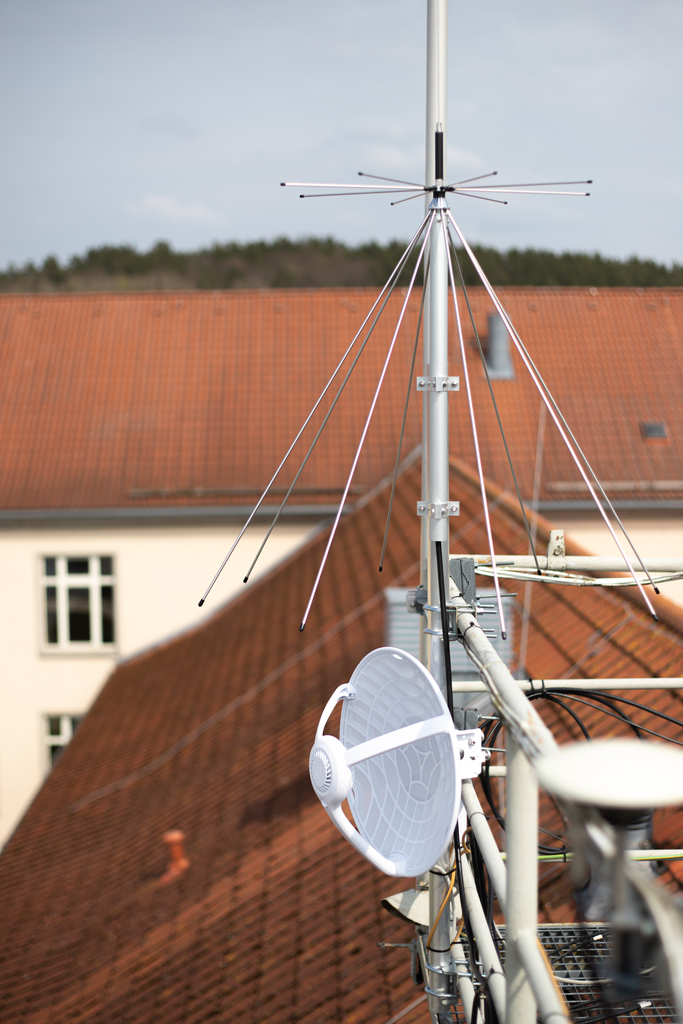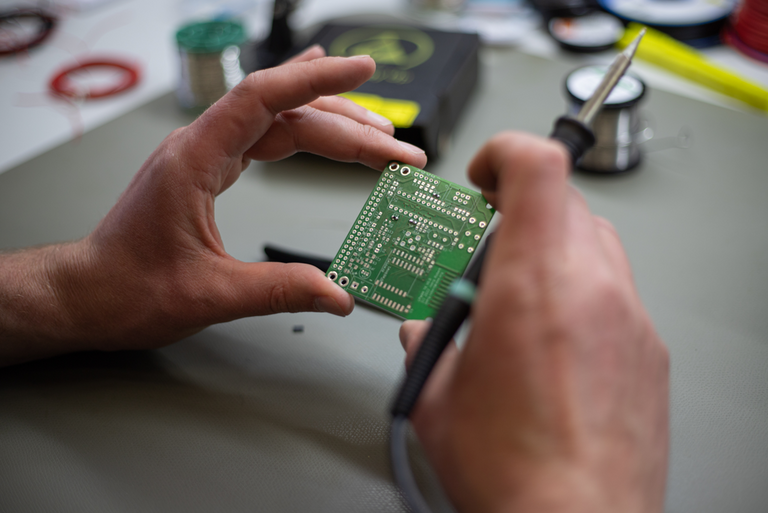Energy-efficient and inexpensive - these are the characteristics that distinguish data transmission in low-power area networks. Prof. Jörg Robert, head of the Dependable Machine-to-Machine Communication Group, wants to further optimize the communication system and make the sensors used in the network more power-efficient and smaller. In a real laboratory above the roofs of Ilmenau, the scientist is testing the technology for measurements in various applications.

"In the energy transition, power-saving and cost-effective technologies are more in demand than ever," knows Prof. Jörg Robert, head of the Reliable Machine-to-Machine Communication Group at TU Ilmenau. For this purpose, the scientist uses his know-how in the field of radio technology and develops energy-efficient sensors that are used in so-called Low Power Area Networks (LPWAN). Attached to radiators, in water meters or outdoors, they record data such as room temperature, water consumption or humidity. The signals are sent to a receiving station and then analyzed by computers. Prof. Robert explains the applications for which LPWAN networks are particularly well suited:
LPWANs are similar to WLAN communication systems for data transmission, but in which only small amounts of data such as measured values are transmitted. This is perfectly sufficient for a large number of applications. The parameters recorded can then be used to predict whether the power grid is overloaded, for example, or whether there is a risk of forest fires. This is exactly what such systems are designed for.
LPWAN communication systems consume very little power and are therefore considered particularly energy-efficient. Powered by a battery, the sensors used in the network have a service life of ten years. At less than one cubic centimeter in size, they are also small and unobtrusive, allowing them to be easily placed in buildings, at various locations in a city, or in a natural area. Distributed in hundreds of ways, they support their users in taking measures to reduce energy consumption in various application areas.
To further reduce the power consumption of the sensors and make them more environmentally friendly, Prof. Jörg Robert has set himself the research goal of replacing the battery built into the sensors with alternatives such as solar cells or thermoelectric generators:
We are currently investigating different ways to further minimize energy consumption. Our goal is to eventually not have to use batteries at all. This would be very practical for a wide variety of applications, especially in nature, because then the battery would no longer need to be replaced at all.
Since the battery takes up most of the space, the sensors with alternative power sources would be built even smaller.
Deployment at Munich Airport

To find out how sensor data can be transmitted with even lower energy consumption in the LPWAN network, Prof. Robert and his team set up an LPWAN testbed in Ilmenau. Two base stations were set up on site on the roof of the Helmholtz Building and on an amateur radio station at the Pörlitzer Höhe with the support of the Deutscher Amateur-Radio-Club e.V.. Another station in the city is currently being planned. They serve the scientists as a real laboratory, as the head of the department explains:
In the testbed, we can test a number of applications in cooperation with the city of Ilmenau - for example, monitoring river levels, checking the water content of the soil or automated reading of electricity. In this way, we receive important feedback from the user side, which gives us conclusions about how we can further optimize our sensors and build them to be even more energy-efficient.
The testbed will also be used for other research projects.
The collected data will be decoded in a laboratory and then passed on to the cooperation partners. In addition to a cooperation with the Ilmenau municipal utilities, Prof. Jörg Robert's young department, which has been in existence since February 2021, is also working with Munich Airport. The company uses the LPWAN system, MIOTY, co-developed by Prof. Robert at the Fraunhofer Institute for Integrated Circuits, to optimize its air conditioning system. The low-cost technology allows the airport to attach a large number of wireless sensors and thus control their air conditioning system more precisely. The professor is making an open source version of the MIOTY system available to interested parties, such as students or startup founders, to try out for free:
There are various systems and providers on the market. However, the MIOTY system is becoming more and more in demand because it works smoothly even with many sensors concentrated in one location and is thus particularly robust.
Intelligent communication technologies
In addition to the further development of sensor technology in the LPWAN system, application-oriented research at the Dependable Machine-to-Machine Communication department is concerned with the Internet of Things. The researchers are investigating how everyday objects can communicate intelligently with each other to optimize daily processes. In doing so, they are driving the 6G mobile communications standard. Engineering students are involved in research at an early stage and take on independent tasks, including taking measurements or simulating technology proposals, which are then used in 6G development.
With his appointment as department head, Prof. Jörg Robert is returning to his roots. In 2000, he studied electrical engineering and information technology at the TU Ilmenau. Later, he conducted research in the field of digital television at the Institute of Communications Engineering at the TU Braunschweig. Here he was actively involved in the development of DVB-T2, the second generation of digital terrestrial television. In 2013, he completed his doctorate at the TU Braunschweig on the topic of "Terrestrial TV Broadcast using Multi-Antenna Systems". Already in 2012, he moved to the LIKE chair at the Friedrich-Alexander University Erlangen-Nuremberg. In his research area LPWAN he led the international standardization of LPWAN within IEEE 802.
In addition to his professorship at TU Ilmenau, Prof. Jörg Robert works at the Fraunhofer Institute for Integrated Circuits IIS in Ilmenau and Erlangen. In interdisciplinary cooperation with the staff of the institute as well as with several departments of the TU Ilmenau, Prof. Jörg Robert would like to further develop his field of expertise:
With my professorship, I would like to leave a footprint in science. The very good environment at TU Ilmenau and the close networking of the players are optimal conditions for this.
The LPWAN testbed is one of five pilot projects being carried out at the performance center Intelligent Signal Analysis and Assistance Systems InSignA. The performance center was launched in March 2021 and aims to establish itself as a research and development partner for manufacturing companies as well as for energy providers and robotics companies. Through the close cooperation of the research institutions in the performance center with small and medium-sized enterprises (SMEs) in the region, the companies are to receive direct support with regard to their product developments and innovations. The TU Ilmenau, five Thuringian Fraunhofer Institutes and the IMMS Institut für Mikroelektronik- und Mechatronik-Systeme gemeinnützige GmbH work together in the performance center.
Contact
Prof. Jörg Robert
Head of the Group Dependable Machine-to-Machine Communication


